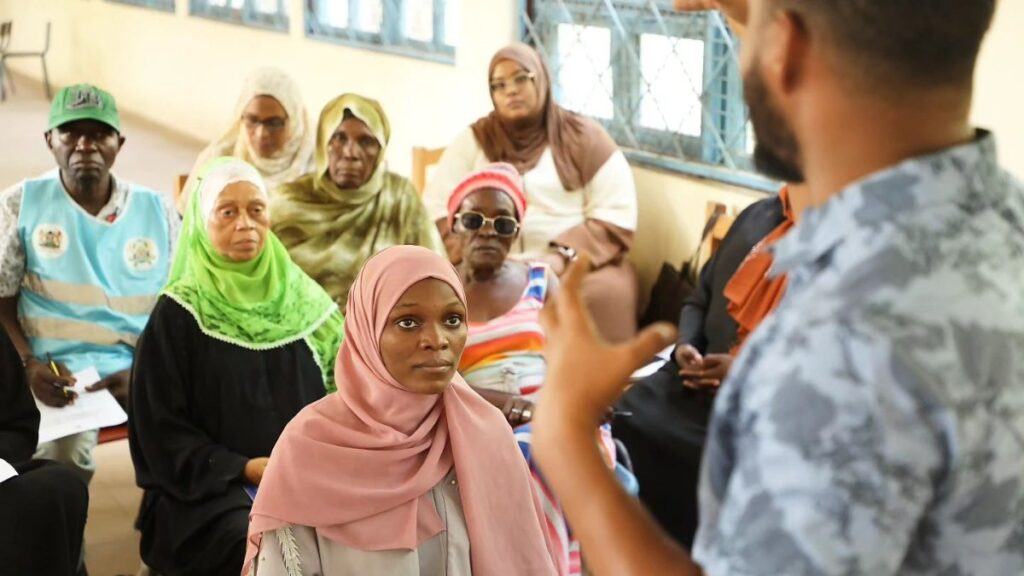Community scorecards in Kenya continues to empower locals towards quality health care
Cet article d’actualité est disponible uniquement en anglaise.
Published: 5 July 2024
Mombasa County, situated along the coastline is Kenya’s second largest city. Home to around 1.3 million people, the vibrant region is known for its beautiful beaches, attracting visitors from around the world. However, the region faces significant health challenges with diseases such as malaria and neglected tropical diseases (NTDs) such as Chikungunya posing serious health threats to the well-being of its residents and visitors alike. As such, a strong health system is essential in enhancing the region’s health service delivery. Community members can play a key role in contributing to health systems strengthening including through the community scorecard process.
This importance of community involvement was well illustrated during the roll-out of the Community Scorecard in June. “Madam Aisha has been to my home many times. I am grateful for her commitment as a Community Health Promoter in checking on the health and well-being of my family,” one community member shared, with resounding claps and reiterations in the background. However, another elderly woman voiced her frustrations about the limited availability of commodities, “I am an old woman and have many ailments including arthritis. Any time I go to the clinic, all I get is Panadol.”

These sentiments were part of a larger conversation at a community feedback session led by Community Health Promoters (CHPs) on the quality of health care services across the six different sub-regions making up the larger Mombasa County. These interactions formed part of the objectives of the Community Scorecard roll-out. The process began with a sensitisation session for key regional leaders and lawmakers, highlighting the significance of the Community Scorecard in healthcare delivery. This was followed by Training of Trainers for sub-regional focal points, who then trained CHPs in their respective areas. The training culminated in community feedback sessions aimed at empowering community members, to play an active role in improving health services by holding providers accountable and ensuring their feedback was heard.
Developed through multi-stakeholder consultations, the Kenya Community Scorecard is a key component of the Kenya Community Health Strategy 2020–2025. This strategy underscores a rights-based approach, recognising that every citizen is entitled to the highest standards of health as enshrined in the country’s constitution. Providing a collaborative framework, the community scorecard allows for joint efforts between community members, health workers, and local governments to respond to community needs and enhance the health system.
John Wanyungu, the Deputy Head in the Division of Community Health Services at the Kenya Ministry of Health, oversees monitoring and evaluation, surveillance, and research. With 23 years of service, Wanyungu has a vast track-record in various departments, including the National AIDS Control Programme (NASCOP) and health sector coordination during the devolution of health services in 2015.
The Division of Community Health is responsible for implementing the National Community Health Strategy and building structures at the first level of the health system. The health system in Kenya has six levels, with the first being the community level, followed by dispensaries, health centers, county hospitals, regional referral hospitals, and national referral and teaching hospitals.
John Wanyungu, the Deputy Head in the Division of Community Health Services at the Kenya Ministry of Health
At the community level, the division focuses on establishing community health units, each staffed with 10 Community Health Promoters (CHPs) and supervised by a Community Health Assistant. These CHPs visit households to assess health conditions and refer individuals needing specialised services to linked health facilities. They address various health needs, from ensuring pregnant women receive prenatal care to ensuring children adhere to immunisation schedules.
The Community Scorecard was introduced in Kenya three years ago with the support of the African Leaders Malaria Alliance (ALMA). Wanyungu noted, “we lacked a mechanism for getting feedback from communities about their perceptions of health services. The uptake of some health services was declining, and we needed to understand the barriers.” The scorecard evaluates nine priority indicators, including respectful and compassionate care, waiting times, and availability of commodities among others. This feedback helps address gaps in service delivery and improve health outcomes.
According to Wanyungu, the Community Scorecard – already in use in other parts of the country has revealed significant insights, particularly around the respect and compassion communities feel when visiting health facilities. Issues like waiting times and staff attitudes have been highlighted, prompting targeted interventions including training, mentoring and remedial measures such as recruiting additional staff. The community scorecard has proven to be a powerful tool for driving change in public health facilities.
The ultimate goal is to roll out the Community Scorecard in every region across Kenya. Currently active in 13 regions/counties, the Ministry plans to expand to 20 regions within the year. The Kenya Community Scorecard is not just a feedback mechanism, but a vital tool in bridging gaps in the health system, ensuring accountability, and encouraging a collaborative approach to health service delivery. Through this initiative, Kenya is making significant strides towards achieving Universal Health Coverage (UHC) and improving the overall health and well-being of its citizens.